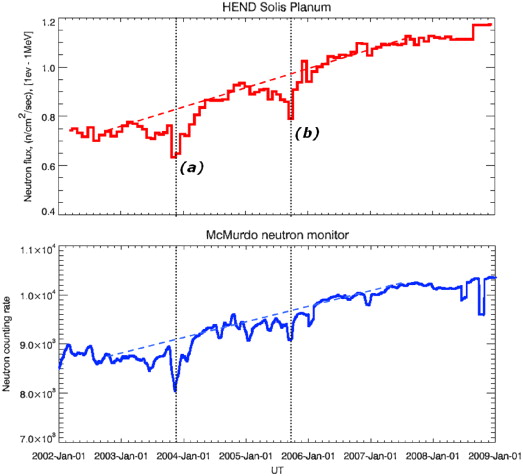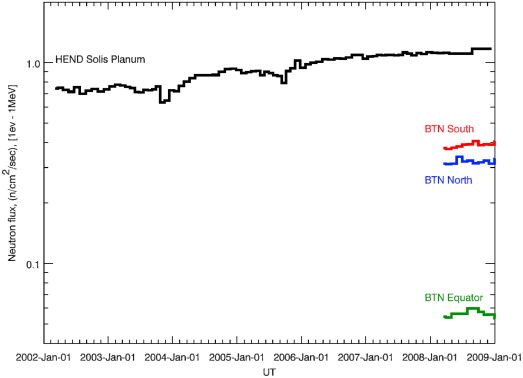Neutron components of radiation environment in the near-Earth and near-Mars space
I. Mitrofanov, M. Litvak, V. Tretyakov, M. Mokrousov, A. Malakhov, A. Vostrukhin
Institute for Space Research, Moscow 117997, Russia
Abstract - Comparison is presented for neutron components of radiation environment in the near-Earth and near-Mars space, which is based on data from high energy neutron detector (HEND) instrument onboard NASA Mars Odyssey and data from BTN-M1 instrument onboard Russian segment of International Space Station.
DOI: 10.1016/j.pss.2009.08.005 -
http://www.sciencedirect.com/science/article/pii/S003206330900244X#bibl001
-------------------------------------------------------------------------------------------------------------------------------------------------
-------------------------------------------------------------------------------------------------------------------------------------------------At the present time there are two similar neutron detectors operating in the near-Mars and near-Earth space. The first one is high energy neutron detector (HEND), which was delivered to the Mars orbit in 2001 by NASA's "Mars Odyssey", as part of gamma-ray spectrometer suite (Boynton et al., 2004). Second instrument BTN-M1 is now operating onboard International Space Station (Tretyakov et al., 2009). BTN-M1 uses spare flight unit of HEND, as the suite of detectors (called BTN-MD for BTN-M1 project), which is encapsulated inside the BTN-MF unit (supporting structure outside ISS). This unit was installed on the outer surface of ISS service module "Zvezda" in November 2006–February 2007 during two EVAs by Michael Turin and Michael Lopez-Alegria (ISS Expedition 14). Special electronic interface unit BTN-ME was designed to support operations of BTN-MD onboard ISS. This unit was installed inside the cabin of "Zvezda" module, and its integration with BTN-MD was done through available hermo-connectors on the wall of this module. Flight operations of BTN-M1 have started in February 2007, and after one year long commissioning stage the instrument operates since March 2008 continuously in permanent configuration for science measurements. Therefore, HEND onboard "Mars Odyssey" and BTN-M1 onboard ISS are working now in parallel, producing simultaneous data for neutron components of radiation environment both in the near-Earth and near-Mars space.
Each celestial body is known to be under bombardment by energetic particles of galactic cosmic rays (GCR) and by particles of sporadic solar particle events (SPE). The magnetosphere of the Earth protects the near-Earth space from this bombardment at moderate latitudes, but contains energetic particles in the radiation belts. At polar regions magnetic lines channel these particles down to the atmosphere. Secondary neutrons are produced by these particles at the upper most layer of the atmosphere, and large fraction of them leaks out to the near-Earth space. The leakage flux of neutrons contributes to the radiation environment in the near-Earth space, which intensity is increasing towards the magnetic poles. Also, there is the particular region of the Earth magnetosphere, the Southern Atlantic Anomaly (SAA), where the radiation belt contacts with the upper atmosphere. Enhancement of the flux of secondary neutrons is observable in the near-Earth space in the vicinity of SAA (Chishiki et al., 2002).
Penetration of galactic cosmic rays into the inner volume of the solar system is known to be modulated by 11 years cycle of solar activity (Belov et al., 1996). At solar minimum, the heliosphere shrinks, and the flux of GCR gets the maximum in the inner volume of the solar system. On the other hand, at solar maximum the heliosphere expands, and flux of GCR becomes minimal in the inner volume of the solar system. Therefore, one may expect that neutron component of radiation environment of the near-Earth and near-Mars space varies along the solar cycle.
Data from HEND at the orbit around Mars covers the time period from February 2002 till now. It was found that spatial temporal variations of neutron component of radiation environment of Mars are quite large ( [Mitrofanov et al., 2002] and [Mitrofanov et al., 2003] ; Litvak et al., 2006). Mars is known to have no strong magnetic field and very thin atmosphere. Particles of GCR penetrate down to the martian surface, and secondary neutrons are produced within an upper most layer about 1 m thick. These neutrons easily leak out to the near-Mars space and contribute into the local radiation environment of Mars. Spatial variations of neutron emission are resulted from changes of regolith composition, and mainly from changes of hydrogen content in the regolith. Due to Mars Odyssey observations, it was found that Mars has very high content of water ice in subsurface above the latitude of 60° at north and south, which results to decrease the leakage flux of epithermal neutrons by a factor of 6 in comparison with the maximal flux from a dry soil of Solis Planium (Mitrofanov et al., 2002).
One may use the Solis Planium region on Mars with coordinates 300°–315°E, 30°–45°S, as the best reference area for studying the long-term variations of neutron component of radiation environment in the near-Mars space. There are no variations of composition of regolith in this area along the Martian year, and therefore one may postulate that change of neutron emission at Solis Planium is resulted from time variations of GCR only. Fig. 1 shows the variation of flux of epithermal neutrons at the energy range 1.0 eV–1.0 MeV at the altitude of 400 km above the Solis Planium area. This interval covers decay stage of the 23rd solar cycle from its maximum at 2001–2002 down to the minimum at 2007–2008. All time periods of Solar particle events were excluded and only time periods were used for flux estimations, when secondary neutrons from the Mars surface are produced by GCR only. Errors of flux evaluation are very small about 10%. It is evident that total flux of epithermal neutrons has increased during this time in about 1.5 times from 0.73 up to 1.1 n cm−2 s−1 (Fig. 1). There are two deep features (a) and (b) at this profile of average neutron flux. The first one (a) is associated with the period of maximal flaring intensity of Sun during the 23rd cycle, which took place in October–November 2003. Total area of active regions on the Sun was the largest for the 23rd cycle during this period (Ishkov, 2003; Veselovsky et al., 2004). The second deep feature (b) was observed in September 2005, when Sun had the very powerful active region AR 10808. This one was one of the most powerful active regions for all history of solar observations (Ishkov, 2003). Assuming the linear interpolation for increasing of neutron flux (Fig. 1), one may identify these two deeps with two prolong depressions below the linear rise, and the amplitudes of these deeps could be as large as 19–23%.

Fig. 1. Long-term variations of emission of epithermal neutrons from the Solis Planium region in the near-Mars space according to data from HEND onboard Mars Odyssey at altitude of 400 km (top) and neutron counting rate by McMurdo neutron monitor on the Earth (bottom).
For comparison, the data of McMurdo surface neutron monitor are also presented for the same period of time (Bieber et al., 2005). There is very good correlation between time profiles for epithermal neutrons in the near-Mars space according to HEND data and for data of McMurdo counters, but increasing factor for the second profile is smaller about 1.2. This difference could be resulted from the fact that neutron emission from Mars is mainly produced by protons of GCR with energies about 100 MeV, while McMurdo monitor data represents GCR at/above 0.5–1.0 GeV. It is interesting, that two deep features (a) and (b) are well observable in the time profile of neutrons from McMurdo monitors. Assuming the linear interpolation for rising profile, one would get the amplitude of deeps (a) and (b) for McMurdo flux, as about 10% and 7%, respectively.
Data from BTN-M1 is now available for the period started from March 2008. Average time profiles of fluxes of epithermal neutrons at the energy range from 1 eV up to 1 MeV are presented for the latitude belt (−3°; +3°) at the Earth equator and for two latitude belts (45°; 52°) and (−45°; −52°) at northward and southward portions of the orbit of ISS (Fig. 2). SAA does not make any significant contribution into the average flux at these belts. Very small flux of epithermal neutrons about 5×10−2 n cm−2 s−1 at the equator is explained by magnetic shielding of the near-Earth space from GCRs. Some larger flux of epithermal neutrons about (3–4)× 10−1 n cm−2 s−1 is observed at high latitudes 45–52° due to penetration of trapped energetic particles down to the atmosphere along lines of dipole magnetic field. These measurements are consistent with previously obtained results (see e.g. Armstrong et al., 1996; Dudkin et al., 1996; Lyagyshin et al., 2001).

Fig. 2. Time profiles of fluxes of epithermal neutrons detected by HEND onboard Mars Odyssey (black) and by BTN-M1 onboard ISS (red, blue and green). (For interpretation of the references to colour in this figure legend, the reader is referred to the web version of this article.)
There is significant difference between the average fluxes of epithermal neutrons in the near-Earth and near-Mars space. Due to magnetic shielding of the Earth, the flux of neutrons on ISS is about 2.5–3.0 times smaller at the latitude of 50° and about 20 times smaller at the equator in comparison with the flux measured by HEND onboard Mars Odyssey. Synchronous operations of HEND and BTN-M1 will continue in future, when the next 24th cycle of solar activity will start the rise. There were no strong solar events during the current period (2008–2009) of synchronous observations by HEND and BTN-M1. On the other hand, there should be a lot of them within the next few years. Measurements of neutron component of radiation environment in near-Earth and near-Mars space together with surface neutron monitors during the rising phase of the 24th cycle will provide more data characterization of variations of GCR in the inner volume of the solar system.
Also, the future manned missions to Moon and to Mars should take into account with the highest priority the radiation conditions in space. Data from near-Earth and near-Mars space during the cycle of solar activity will become very important for creating the engineering model of radiation conditions for the interplanetary flight. Data from Mars orbit represent interplanetary environment quite well, since Mars does not have magnetic field, and radiation estimation can be done by taking into account shadowing a part of hemisphere by Mars. However, ISS measurements are being conducted under significant reduction of GCR by Earth magnetosphere. Comparing data from Earth and Mars orbits allows us to make quantitative and qualitative extrapolation of radiation data in near-Earth space to interplanetary environment.
Armstrong et al., 1996 T.W. Armstrong et al.. Radiation Measurements, 33 (1996), p. 229.
Belov et al., 1996 A. Belov, R. Gushchina and I. Sirotina. Radiation Measurements, 26 3 (1996), pp. 471–475.
Bieber et al., 2005 Bieber, J., Evenson, P., Pyle, R., 2005. Bartol Research Institute neutron monitor data. Bartol Res. Inst., Univ. of Del., Newark, available at 〈http://neutronm.bartol.udel.edu/〉
Boynton et al., 2004 W. Boynton et al.. Space Science Review, 110 1 (2004), pp. 37–83
Chishiki and et al., 2002 Chishiki, A., et al., 2002. In: Proceedings of the Second International Workshop on Space Radiation Research, Nara, Japan, 11–15 March.
Dudkin et al., 1996 V.E. Dudkin et al.. Radiation Measurements, 26 (1996), p. 535.
Ishkov, 2003 Ishkov, V., 2003, In: Proceedings of ISCS 'Solar Variability as an input to the Earth's Environment' (ESA SP-535, September 2003). pp. 103–104.
Litvak et al., 2006 M. Litvak et al.. Icarus, 80 (2006), p. 23.
Lyagyshin et al., 2001 V.I. Lyagyshin et al.. Radiation Measurements, 33 (2001), p. 313.
Mitrofanov et al., 2002 I. Mitrofanov et al.. Science, 297 (2002), pp. 78–81.
Mitrofanov et al., 2003 I. Mitrofanov et al.. Science, 300 (2003), p. 2081.
Tretyakov and et al., 2009 Tretyakov, V., et al., 2009. Cosmic Research (Russian Kosmicheskie Issledovaniya), in press.
Veselovsky et al., 2004 I. Veselovsky et al.. Cosmic Research, 42 (2004), p. 435.



